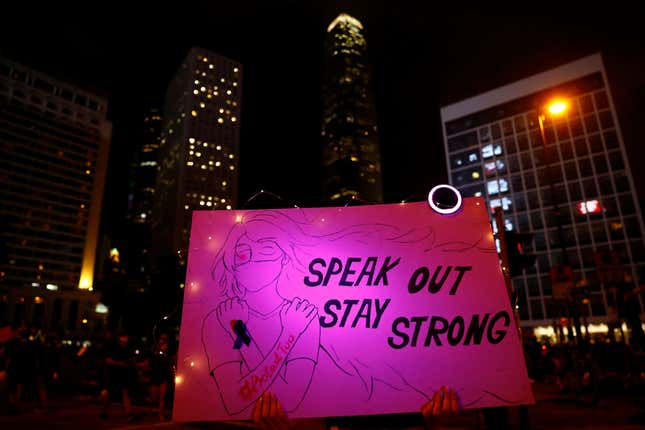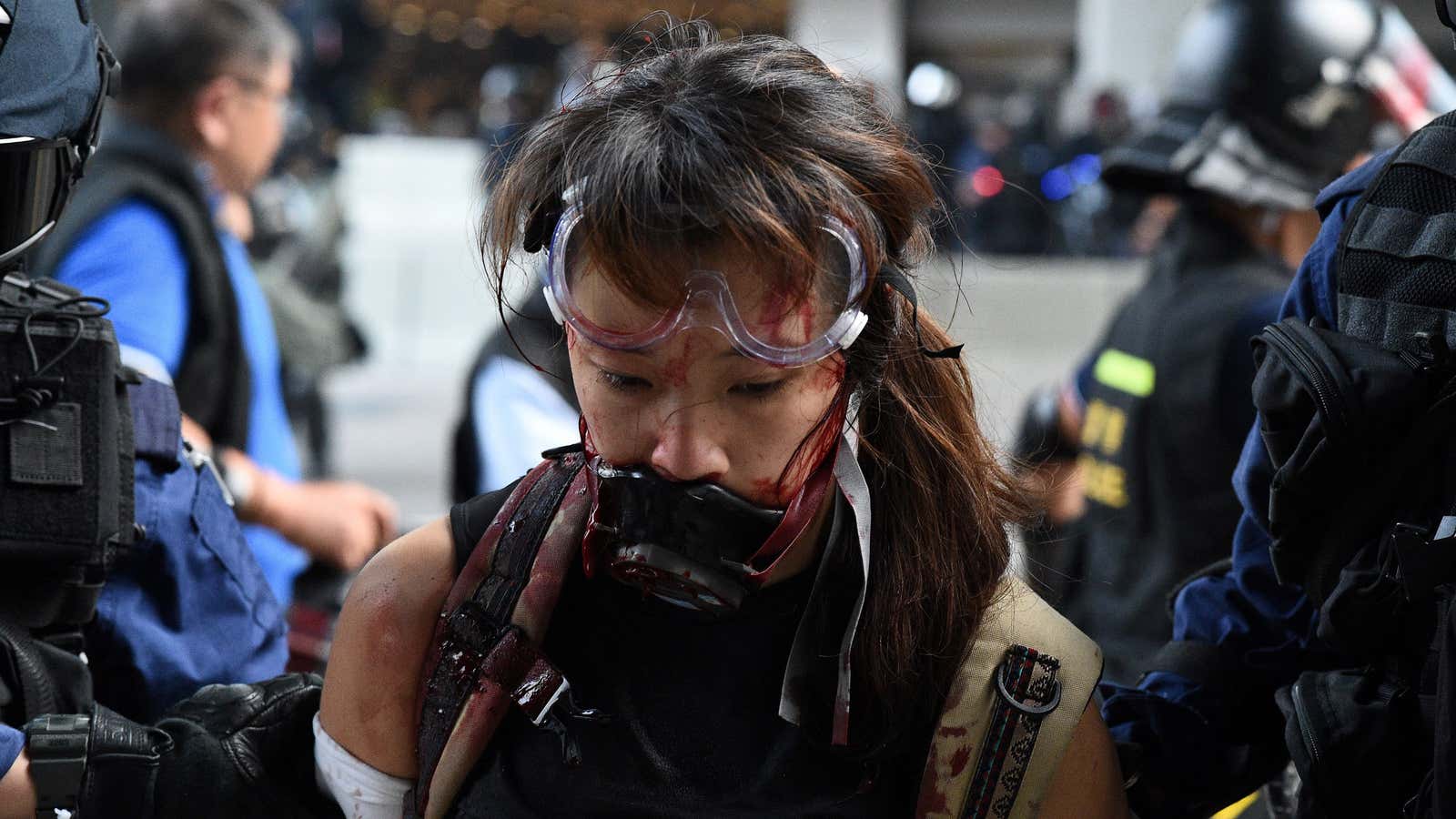There are Hong Kong girls, and then there are “Kong Girls.”
A Kong Girl, or a Gong Nui in Cantonese, is broadly described as a young Hong Kong female who is materialistic, apolitical, high-maintenance, and temperamental. The term “Princess Syndrome” has also been widely used to characterize such women, as epitomized by a viral video in 2013 showing a Hong Kong woman slapping and berating her kneeling boyfriend in public.
“A Kong Girl only thinks about where to eat, she’s scrolling on OpenRice all day, planning her next trip to Japan… It’s almost like a Hong Kong version of what people understand as a ‘basic bitch,'” said Karen Cheung, a 26-year-old Hong Kong-based writer who has taken part in the protests this year, referring to the city’s version of Yelp.
“Brave Fighters”
In recent months, however, many have watched in awe as a new type of Kong Girl emerged out of this year’s protests, as women lobbed back tear gas grenades, built heavy-duty barricades, and stood in the frontlines to face an arsenal of increasingly powerful police weapons such as rubber bullets and bean-bag rounds.
“We can see a different side of Hong Kong girls. Some of them might display ‘Kong Girl behavior’ to their boyfriends or family before the protests, but (at the) frontline they are brave, courageous, and resourceful. Some females even go further than the guys,” said a 23-year-old female protester and office worker who only wanted to be identified as Poppie out of concerns for her safety.
In short, Hong Kong’s women have thrown themselves into the ranks of what’s known as the “brave fighters” segment of the protesters, marking a significant escalation from the roles played by women in the 2014 Umbrella Movement protests.
Those protests five years ago—which were a call for more representative democracy—too marked a sort of coming of age for Hong Kong’s “pampered” women, as they played key roles during the months-long occupation of Hong Kong’s streets by taking charge of logistics, cleaning, and activities such as a “study corner.” But some also faced sexual harassment and assaults, including being grabbed by men who launched organized attacks on the occupied sites. One teenage girl considered suing a police officer for sexual assault after he allegedly touched her chest during an altercation.
While such incidents shocked people at the time, they pale in the comparison to the level of violence seen in this year’s protests, which kicked off in June in opposition to a now-shelved extradition bill. Over 2,000 tear gas canisters have been fired throughout the protests, compared to just 87 in the Umbrella Movement, with two incidents of shootings of teenagers by police officers with live rounds in the past week marking the most severe use of force so far. Human rights advocacy group Amnesty said in a recent report that police were conducting “abuses against protesters that take place out of sight,” including severe beatings while in detention. Police said that the report was missing context, and have defended their actions as restrained in the face of life-threatening actions from protesters.
Some of the most serious injuries have been inflicted on women, including on a volunteer first-aid provider who was shot in the eye by a projectile outside a police station during a protest in August, inspiring a campaign in which protesters covered one eye in solidarity. Police say the incident is being investigated. In another incident that month, a young woman’s crotch was exposed when police carried her away during her arrest.

#ProtestToo
The allegations of police brutality include multiple accounts of sexual assault directed against women, including one from a protester who has accused a police officer of conducting an invasive naked body search after she was arrested. In response to those allegations, protesters organized a #MeToo protest in a central Hong Kong square in August, with tens of thousands of black-clad supporters turning out in a city where the global anti-sexual-harassment movement has had a minimal presence. They listened as women with their faces obscured took to the stage to share their experiences of the police, with the words “#ProtestToo” written on their arms in support of the protesters.

The police force has defended the use of full-body searches as necessary but said it would follow up on other allegations of mistreatment seriously.
Now, a newfound respect for Hong Kong women can be discerned. According to Cheung, the media are starting to “spin the term ‘Kong Girl’ in a more positive way” as a result of the protests. “We can reclaim this term. Who cares if we do all the stuff that people say we do? It doesn’t mean anything about our commitment to Hong Kong.”
Doxxing and rape threats
In addition to facing the specter of assault by police or civilians each time they take to the streets, Hong Kong’s female protesters are also facing rape threats and doxxing online—all the while as the government continues to take to outdated tropes to portray women.
Chief executive Carrie Lam has herself repeatedly resorted to portraying herself as a loving mother trying to rein in the city’s youth, or her spoiled children—a comparison that has been widely rejected and mocked by the movement’s participants. Fanny Law, a member of Lam’s cabinet, went as far as to claim that young women were offering sex to male protesters, based on information she had “heard second-hand” from a friend. Her comments, widely panned, echoed slurs used by Beijing supporters depicting not only female protesters, but also journalists, as “comfort women” serving a foreign master, a term typically used to refer to the women used as sex slaves by the Japanese army during World War II.
Those comments struck at the heart of what many in Hong Kong’s older generation believe about not just young women, but young people as a whole—that it’s inconceivable that a populace long believed to be apolitical are willing to put their lives on the line for their beliefs. People are “surprised” at Kong Girls in the same way that they’re “surprised that people have come out to the protests,” said Cheung.
Jane Chan, a lecturer at the Hong Kong Polytechnic University who has studied the Kong Girl phenomenon, and has students who have taken part in the protests, said that the high participation of women in the protests is because many simply believe they are entitled to the same opportunities as men when it comes to standing up for their beliefs.
“They wear make-up under their masks. They’re young and want to look pretty. But they still want to do something for Hong Kong.”
